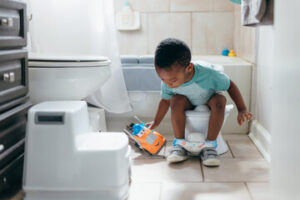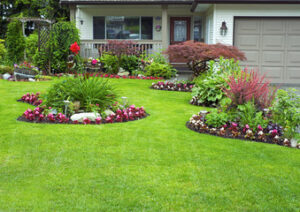Getting your child out of nappies is a big step. Start with a small, portable potty and get other family members on board.

Make trips to the potty a regular part of your routine. Seat them on the potty chair first thing in the morning, before going out, and before naps and bedtime. Expect hesitancy; it’s a new step for most children. Keep reading the article below to Learn More.
Children are ready to start potty training when they’re interested in the toilet and wearing underwear. This usually happens around two to two and a half years for girls and about six months older for boys. It could be even earlier, though, if your child shows clear signs of readiness and you’re noticing they need to pee or poop before you remove their diaper. It’s also helpful if they’ve seen other family members of the same sex using the toilet to wee or poo, and understand what it’s for.
One of the most important signs is that your child has a general interest in the bathroom and toilet, especially when it’s time to use them. It’s also great if they tell you when they need to pee or poop and can sit on the potty without you having to push them.
Another sign is that your child can remain seated for a period of time while doing something else, such as playing with toys or eating. This shows they have the physical strength to control their bladder and bowels, which is essential for successful potty training.
It’s also a good idea to have your child wear clothes that are easy to take off (e.g., pants with no snaps in the crotch or shorts). This helps them get undressed quickly and feel confident when they’re sitting on the potty. Finally, it’s best to avoid starting potty training when your child is sick or has diarrhea. It can make it harder for them to learn, and they may have accidents that are more difficult to clean up.
It’s also a good idea to wait until your child has a stable schedule of daily activities, and a predictable day-to-day routine. This will help them stay focused and not be distracted by other things going on in their life. It’s also important to try to avoid major changes to your child’s diet or routine, as this can make it more challenging for them to cope with potty training. A big change can also cause kids to go back to their old ways, so don’t worry if your little one goes back to wearing diapers for a while.
How do I start potty training?
Ideally, your child should start potty training when they’re physically ready. However, every child is different and will progress at their own pace. You can help your child move more quickly by encouraging their independence. It is important to keep in mind that children will have accidents as they learn to use the potty. Rather than punishing them or getting angry, show your child that accidents are normal and that they will eventually learn to stay dry throughout the day.
Begin by setting up a baby potty chair on the floor of your bathroom and letting your child play with it with their clothes on. When they’re ready to begin training, ask them to take off their pants and socks (boys may need to take off their underwear as well) and then sit on the potty chair. Some experts recommend using formal words such as defecate or urinate so that your kids will be comfortable with the process later, and avoid slang such as “pee” and “poo.”
Explain to your child what they’re doing on the potty chair and why you need them there. Many children feel hesitant about having their parents watch them do this and may try to resist the process. Encourage them to sit on the potty by reading a book, playing a game such as 20 Questions, or simply talking with them so that they’re more at ease.
After a few days, you’ll want to start having your child sit on the potty chair regularly without having to wear a diaper. This will help them establish a habit and will allow you to catch any signs that they might be about to have an accident. First thing in the morning, before you leave the house, and before naps and bedtime are all good times to make sitting on the potty part of your child’s routine.
Once your child has established a potty routine, you can remove their diapers completely and switch to either cloth training pants or underwear. If they’re still unable to remain dry at night, it might be time to consider back-up options such as a bedtime pull-up.
How do I help my child learn to use the potty?
It can be frustrating when your child is learning to use the potty. But if you make the experience positive, you can help your child become fully independent and learn to love going to the bathroom.
The best approach is to let your child take control of the process as much as possible. This will encourage them to want to succeed, and it’s less likely to backfire on both of you when they have an accident. Don’t force them to sit on the potty against their will, and be sure to praise them for every success (even if they didn’t go).
Make the bathroom a comfortable, inviting place, and help your child to understand what the toilet is for by allowing them to see you using it. This will help them feel like big kids, and will get them excited to learn.
Give your child a chance to explore the potty chair or toilet seat with clothes on, and then without. Help them to learn how it works by emptying the potty into the toilet together and letting them flush. Some children respond well to small rewards, such as stickers and made-up “coins” for reading or music time. Be careful not to overuse these, as they can make your child feel entitled and may delay their progress.
Set a regular schedule for potty breaks. It’s a good idea to have your child sit on the potty with their pants and diaper off at two-hour intervals, as well as first thing in the morning and right after naps. Teach your child to recognize the feeling of needing to pee and poop, by asking them if they are going pee or poopey and letting them know that you will take them to the bathroom when this happens.
Encourage your child to stay on the potty by having them read a book or play with a toy while they are sitting there. Try to avoid activities that are too messy or require a lot of bending over. It is also helpful to dress your child in clothing that’s easy to pull down, such as trousers with an elastic waistband and a loose shirt.
How do I encourage my child to use the potty?
Keeping the toilet-training process positive and fun is important for your child. Encourage him to sit on the potty by offering his favorite toys, books or TV shows. Make trips to the potty a routine, particularly first thing in the morning and after meals and before naps. Boys can even try sitting on the potty to urinate when they feel the urge, which helps them learn that they have control over their bladders and can be independent.
When your toddler does use the potty, be sure to praise him. This goes a long way in boosting his confidence. It’s also a great way to help him build a strong foundation of good hygiene.
Some experts recommend using formal words, like defecate and poop, instead of baby-talk terms, such as shit and stinky. This way your child will not be embarrassed by these words later in life.
If your toddler is reluctant to sit on the potty, try putting a stool or chair in front of it so they can reach it. Some children find this more comfortable, especially if they are a bit taller than their parents or older siblings.
Keep in mind that some kids take longer than others to get used to potty training, and a few accidents may occur along the way. Try to stay patient and calm, and remember that your toddler has a lot of growing up to do.
A common strategy is to take your toddler to the potty every 30 or 60 minutes for the first few days, with more frequent trips after meals and before naps. Eventually, you will need to check their nappy less and less frequently.
If your child is a boy, you can help him develop the muscle control to urinate on the potty by asking him to sit on the potty with his pants down. Often this will prompt him to empty his bladder and will be much easier than trying to stop him when he is already urinating.

